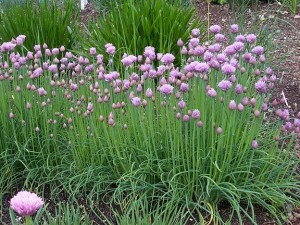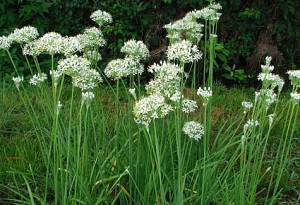
As the snow melts and the plants emerge from their winter slumber, chives are one of the first to appear. My Korean friend said that, in her country, they eat chives in the spring because they believe chives clean the blood. Whether that is true or not, they are a welcome addition to my menu after a long winter. First thing this spring I chopped several leaves up and heated them in a quarter size of olive oil to flavor the oil before I threw in an egg. This is especially good between an english muffin with mustard and a slice of cheese. The next weekend I mixed a good portion of chopped chives with cream cheese and served them with crackers to rave reviews at a garden lecture reception.

Chives are yummy cut up on potatoes, salads, eggs or tossed in a pasta. Chives can also be used to make remoulade and ravigote. I’m not a fan of carrots, but I have been told chives are also good on carrots. For a simple crowd pleaser try chopped chive leaves mixed into softened butter, then refrigerate it again molded into a shape or in a pretty bowl to impress your guests when you serve potatoes or other vegetables. The leaves are best fresh, but you can also freeze them in a plastic bag or dry them to enjoy them during the winter.
Chives are easy to grow either from seed or by dividing a clump. As chives are prolific, if you do not cut the flowers off before they go to seed, it is hard to imagine a gardener who would not happily share a start of their chives with you~don’t be shy just ask!
The flavor of garlic is also in the flowers of the garlic chives. I put the garlic chive flowers in vinegar or the red wine I use for cooking to give them a nice garlic flavor. The cautionary tale is to make sure that the vinegar covers the flowers completely to avoid mold. The flowers from both chives are nice sprinkled on a salad or chopped and mixed in with a soft cheese. Keep in mind that, as with most herbs, lengthly cooking destroys the flavor, so if you are heating them add them near the end of cooking. Enjoy!
– Jill Kuhel


